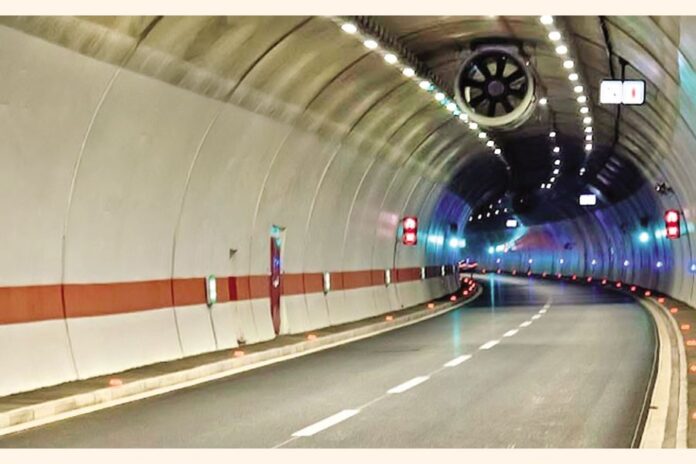Following the opening of the Padma Bridge, 170 million people in Bangladesh are eagerly waiting with joy and excitement for the inauguration of the Bangabandhu Tunnel, another mega project. Time is counting to traverse the dream tunnel.
Prime Minister Sheikh Hasina will open the door to this dream in December. By making the Padma Bridge a reality on June 25 the PM took Bangladesh to new heights on the international stage. The first tunnel in South Asia, which is now being constructed near Chittagong under the Karnaphuli River, has now come to represent Bangladesh’s pride, dignity, and ability to complnmete a megastructure.
An investment-friendly environment drives the economy. Hence, there has been an uptick in the trend of developing infrastructure that is conducive to investment. The government of Bangladesh has therefore boosted investment in the road and rail infrastructure sectors for more than a decade. The Bangabandhu Tunnel will bring a fresh perspective on this area. Implementing a tunnel project for the first time in Bangladesh makes the country more confident. Noteworthy, Bangladesh is now known as the source of wonder in terms of development in many countries of the world.
The plan to construct a tunnel under the Karnaphuli River was unveiled as a project in 2010. The feasibility study report was finalized in 2012 at a cost of Tk 120 million. In December 2014, the Chinese firm CCCC and the Bangladesh Bridge Authority signed a Memorandum of Understanding. The agreement between the two countries was signed on November 24, 2015. On October 14, 2016, Chinese President Xi Jinping and Bangladeshi Prime Minister Sheikh Hasina jointly laid the cornerstone for six projects, including the construction of the Karnaphuli Tunnel.
On 24 February 2019, PM Sheikh Hasina formally opened the tunnel’s construction. Despite two years of corona attacks and other difficulties, the tunnel construction is proceeding as planned. According to the project’s director, Harunur Rashid Chowdhury, the project is roughly 91 percent finished, and by the end of next December, 100 percent of the work will be finished.
Starting from the Naval Academy end of Patenga in Chittagong, the tunnel goes under the river between Chittagong Urea Fertilizer Limited and Karnaphuli Fertilizer Limited factories in Anwara. The main tunnel is 3.32 km long and has two tubes, each with two lanes. There is a 5.35 km connecting road to the west and east of the main tunnel that will allow Cars to run at a maximum speed of 80 km.
Chinese enterprises have carried out a number of significant infrastructure projects in Bangladesh in the transportation, energy, power, and communications sectors, which have helped the country’s economy and society flourish. In this journey, the “Bangabandhu Sheikh Mujibur Rahman Tunnel” represents a milestone in the field of China-Bangladesh cooperation. As this tunnel is built, the port city of Chittagong will be modeled like the Chinese city of Shanghai based on the “One City, Two Towns” design. On either side of the river, there will be two towns.
The tunnel project is being implemented with the joint funding of the Governments of Bangladesh and China (G2G). The total cost of the project is BDT 10.375 billion. The Exim Bank of China is providing BDT 5.913 bilolion, leaving the Bangladeshi government to contribute BDT 4.461 billion. Bangladesh is required to pay this sum plus a two percent interest charge. China Communication Construction Company (CCCC) is carrying out the project under the supervision of the Bangladesh Bridge Authority. About 350 Chinese employees, among the 1200 local and foreign workers, are working here regularly day and night. It is noteworthy that Chinese companies also constructed the country’s multibillion-dollar Padma Dream Bridge.
Building infrastructure is the only option available for Bangladesh’s economic development. As a result, it is anticipated that this mega project will contribute significantly to the country’s growth in terms of commerce, tourism, and communication. In this case, it is hoped China would continue to stand firmly with the people of Bangladesh as good neighbours, good friends, and good partners. In short, China’s support is expected in the form of economic and technological collaboration in the areas of climate change, poverty alleviation, public health, human resource development, and other related areas.
Whenthis project is implemented, the financial and economic IRRs will be 6.19 percent and 12.49 percent respectively. Additionally, the “Benefit Cost Ratio” (BCR) for the financial and economic sectors will be 1.05 and 1.50 percent, respectively. The tunnel will have a positive impact on GDP. The economy will take on a new dimension as a result of massive employment, tourism, and industrialization. At the tunnel’s Anwara end, there are Perki Beach, CUFL, and Korean and Chinese EPZs. With the tunnel, a better and easy communication system will be developed with the Chittagong metropolis, Chittagong port, and airport located on the western end. It will take less time and cost to carry produced goods and raw materials from the eastern industry to Chittagong port and airport.
The southern part of Bangladesh’s road network will undergo a revolutionary change due to the tunnel. A modern communication system will be developed with Cox’s Bazar, Banshkhali, and Matarbari power plants and Matarbari deep sea port via Anwara crossing through the Karnaphuli tunnel. Through it, a connection will also be made to the Asian highway. The tunnel will be used by 7.6 million cars annually after three years of operation.
Another thing that makes us optimistic is the large-scale initiative to construct industrial establishments on both sides of the tunnel. The tunnel will turn the port city into a business hub. Thanks to the media, we have learned that numerous industries are already being established in Chittagong on a massive scale since the start of the tunnel construction. Inactive industrial facilities are being renovated. Fresh initiatives have been taken to build 80 industrial factories including garments, shipbuilding, edible oil, fish processing, steel, and cement on the bank of the Karnaphuli River.
The wheels of the economy in the southern region will experience faster growth. Both the standard of living and employment will increase. “This tunnel will play a significant role in improving the economy in the long run,” economist Professor Mainul Islam stated.
Building infrastructure is the only option available for Bangladesh’s economic development. As a result, it is anticipated that this mega project will contribute significantly to the country’s growth in terms of commerce, tourism, and communication. In this case, it is hoped China would continue to stand firmly with the people of Bangladesh as good neighbours, good friends, and good partners. In short, China’s support is expected in the form of economic and technological collaboration in the areas of climate change, poverty alleviation, public health, human resource development, and other related areas.






















